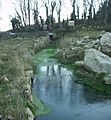Carrickmines Castle facts for kids
Carrickmines Castle is an old castle site in Carrickmines, County Dublin, in eastern Ireland. This castle was built a long time ago, during the Middle Ages, to help protect the area around Dublin that was ruled by the English. This area was known as the Pale.
Most of the castle's old walls and parts of its defenses are now hidden underground. They were in the way of the M50 Motorway, a big road that was finished in 2005. Some parts of the castle were saved and can still be found within or under the roundabouts of the M50 road.
Contents
History of Carrickmines Castle
Carrickmines Castle was first a settlement built by the Hiberno-Norse, who were people of mixed Irish and Viking heritage. In the 1100s, it became a strong Norman castle and village. It stood on the edge of the land between Dublin and Wicklow, acting as a guard for the southern plains.
This fortress was a very important part of the defenses around the Pale. The Pale was the area around Dublin that was controlled by the English during medieval times.
In 1402, a group called the O'Byrne clan from County Wicklow often raided Dublin. They brought a large group of fighters to the River Dargle near Bray. But they seemed to pause before attacking Dublin directly because it would bring them close to Carrickmines Castle. This delay gave the Walsh family, who owned Carrickmines, time to send a quick warning to Dublin.
The people of Dublin acted fast. The Mayor of Dublin led a large force and defeated the O'Byrnes. This fight was known as the Battle of Bloody Bank because many people were hurt.
Carrickmines Castle was a major fortress. It had a very long outer wall with towers to protect a large area. Inside these walls, there was a village with many wooden and stone buildings, mills, and a main building called a hall house or keep in the middle. Today, you can still see impressive defenses carved into the rock. Human remains have also been found from when the castle was taken over in 1642.
During the Irish Rebellion of 1641, the Walsh family, who were Catholic and owned the castle, joined the native Irish. They supported the effort to create the first independent Irish parliament. This had serious consequences for them. English forces attacked the castle as part of the Irish Confederate Wars. When the English took it back, many people from the Walsh, O'Byrne, and O'Toole families, over 300, were killed.
M50 Motorway and "The Carrickminders"
The old castle ruins became the center of a long argument before the M50 motorway was built through the site. This started in 2002 when people who cared about the castle, like Vincent Salafia and Gordon Lucas, camped out on the ruins. They called themselves the "Carrickminders." They wanted to stop the ruins from being removed for the motorway.
Other people who wanted to protect history joined them, including Professor Sean Duffy from Trinity College Dublin and Dr. Mark Clinton, an archaeologist. They argued that the castle site had much more history to discover. They also wondered why the M50 road path was changed in 1998 to go through the castle, when an earlier plan from 1983 had routed the road around it.
In 2005, both the M50 motorway and the road junction were finished.
Court Decision on the Castle
In 2006, the Supreme Court made a decision about Carrickmines Castle. They said that new laws about protecting national monuments were allowed under the Irish Constitution.
The court understood that these new laws, specifically Section 8 of the National Monuments (Amendment) Act 2004, removed some protections from national monuments. However, the court found that the government, through the Oireachtas (Ireland's parliament), could make such laws.
The court also said that the Minister for the Environment could decide what was best. This meant balancing the importance of protecting old sites with the wider public benefit of building the road.
Section 8 meant that the work on the Carrickmines Castle site would follow the Minister's instructions. This effectively meant the road work was no longer fully controlled by the old National Monuments Acts. Even though the castle was a national monument and a large part of a moat found there would be destroyed, the court allowed the work to continue.
The Supreme Court rejected arguments that the Minister's instructions went against European environmental rules. This decision came after an appeal by Dominic Dunne, who had challenged the new laws.
NRA Preservation Plan
The National Roads Authority (NRA) suggested a plan to save large parts of the historical remains. At the same time, they wanted to make sure the motorway could be built on time.
Under their plan, more sections of the medieval walls and parts of the castle's defenses would be kept safe. They would be preserved within or under the M50 roundabouts. However, some groups wanted the roundabouts to be smaller and the roads adjusted, but these requests were not included in the plan.
The NRA and Dún Laoghaire–Rathdown County Council said they had done everything possible to protect the castle. They spent €6 million on digging up the site over two years. Archaeologists found more than 40,000 old items, including weapons, coins, human remains, and pottery, when work on the motorway started again.
Images for kids





